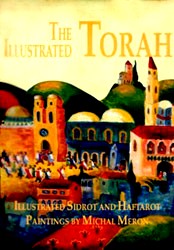The Central Square of the Jewish Quarter
Your next stop is the central square of the Jewish Quarter, encompassing the Ramban Synagogue. Adjacent to the square are the remains of the "Hurva Synagogue" - one of the symbols of the Quarter. The large arch on the site is a reconstruction of one of the Synagogue's four main arches. The Synagogue was destroyed in Israel's War of Independence.
The Herodian Mansions
On Hakara'im Street is the Tiferet Yisrael Synagogue, which was built with a contribution from the Austrian Emperor Franz Josef. The facade is reminiscent of ancient Synagogues in the Galilee.
Also located on Hakara'im Street is the entrance to the Herodian mansions - one of Jerusalem's most impressive archaeological sites. This is a group of five mansions from the Second Temple period, show casing Mikva'ot (ritual baths), baths, mosaics and stucco decorations. The houses were burnt and destroyed during the Jewish rebellion against the Romans in 70 CE.
The Burn House
On Tiferef Yisrael Street, you'll find the Burnt House - an archaeological site that reconstructs the home of the Kathros family - a Jewish family from the Second temple period. The house was burnt at the time of the destruction of the Temple and exciting finds have been discovered there such as a javelin, nails, and the bone of an arm of a women who died in the fire. An Audiovisual presentation depicts what life was like during Second Temple times.
The Cardo
Cross Hayehudim Street and enter the Cardo - the main colonnaded street of Byzanite Jerusalem depicted in many ancient maps of the city. The street, on which numerous shops operate today, incorporates the remains of the ancient street, which was exposed to a length of 180 meters. Recently, a candelabrum designed to resemble the one in the Temple was mounted there.
Old Yishuv Court Museum
A tour in the Old City is not complete without a visit to a museum that shows the way if life of the Jewish population (yishuv) in Jerusalem from the beginning of the 19th century to 1948. The museum is located in one of the ancient courtyards in the Jewish Quarter and its rooms contain exhibits focusing on the various Jerusalem communities.
Cradle of History - The Jewish Quarter offers the visitor unforgettable ancient sites, picturesque streets and synagogues with a unique character.
Batei Mahseh Square - Enter the Old City from the Zion Gate, cross the parking lot and walk through Hatzotzerot (Trumpets) Street - a lovely lane featuring many arches, that conects with Gilad Street and gets you to Batei Mahseh Square. This was the largest square in the Jewish Quarter. New houses were built around the square in the mid-19th century, an important step in easing the severely crowded conditions in the Jewish Quarter. The buildings, which were constructed by a charitable organization in The Netherlands and Germany, were earmarked for the poor of Jerusalem.
In 1871, the German branch of the Rothschild family built the stone structure with the impressive arches. The family's coat of arms adorns the top of the building; it includes the Latin words for honor, energy and honesty. The Quarter's school, with its many domes, stands in the southern part of the Square. Next to the Rothschild House is a tombstone commemorating the fighters who fell in the Jewish Quarter and were buried here in 1948. After the Six-Day War, their remains were reinterred to Mount of Olives.
Batei Mahseh Square - Enter the Old City from the Zion Gate, cross the parking lot and walk through Hatzotzerot (Trumpets) Street - a lovely lane featuring many arches, that conects with Gilad Street and gets you to Batei Mahseh Square. This was the largest square in the Jewish Quarter. New houses were built around the square in the mid-19th century, an important step in easing the severely crowded conditions in the Jewish Quarter. The buildings, which were constructed by a charitable organization in The Netherlands and Germany, were earmarked for the poor of Jerusalem.
In 1871, the German branch of the Rothschild family built the stone structure with the impressive arches. The family's coat of arms adorns the top of the building; it includes the Latin words for honor, energy and honesty. The Quarter's school, with its many domes, stands in the southern part of the Square. Next to the Rothschild House is a tombstone commemorating the fighters who fell in the Jewish Quarter and were buried here in 1948. After the Six-Day War, their remains were reinterred to Mount of Olives.
The Jewish Quarter in Jerusalem's Old City (Hebrew HaRova HaYehudi or the Rova) is one of the four traditional quarters of the Old City of Jerusalem. It lies in the southeastern sector of the walled city, and stretches from the Zion Gate in the south, along the Armenian Quarter on the west, up to the Cardo in the north and and extends to the Western Wall and the Temple Mount in the east.
The buildings of the current Jewish Quarter cover sites and relics from about 2,800 years of history, and sometimes a few stairs bring us to discoveries from the Second or even First Temple period.
During the War of Independence, the Jewish quarter was defended by a unit of the Haganah. On the 15th of May 1948, the Sixth regiment of the Jordanian Legion joined three companies of irregulars in the attack on the Jewish Quarter. The defenders succeeded in holding out for two weeks, then had no choice, but to surrender on 28th of May 1948. Two hundred and ninety people prisoners were taken; the rest of the Jewish residents of the Jewish Quarter were transferred to the new city.
During the Jordanian occupation of the Jewish Quarter from 1948 until the Six Day War in 1967, all the houses in the Jewish Quarter were pillaged, and many synagogues were systematically destroyed.
The buildings of the current Jewish Quarter cover sites and relics from about 2,800 years of history, and sometimes a few stairs bring us to discoveries from the Second or even First Temple period.
During the War of Independence, the Jewish quarter was defended by a unit of the Haganah. On the 15th of May 1948, the Sixth regiment of the Jordanian Legion joined three companies of irregulars in the attack on the Jewish Quarter. The defenders succeeded in holding out for two weeks, then had no choice, but to surrender on 28th of May 1948. Two hundred and ninety people prisoners were taken; the rest of the Jewish residents of the Jewish Quarter were transferred to the new city.
During the Jordanian occupation of the Jewish Quarter from 1948 until the Six Day War in 1967, all the houses in the Jewish Quarter were pillaged, and many synagogues were systematically destroyed.
SPONSORED LINKS (What's this?)
Attractions in Israel
The visit in Israel starts here bonus for the visitors
Jerusalem City Map
Jerusalem maps of rails & subways Download free Jerusalem maps!
Attractions in Israel
The visit in Israel starts here bonus for the visitors
Jerusalem City Map
Jerusalem maps of rails & subways Download free Jerusalem maps!
After the reunification of the City, the Quarter was restored, and Jews could again live there. Houses which could be preserved were restored and new buildings were erected, replacing the ruins.
Today, the Jewish Quarter is an upper-middle-class neighborhood, with an almost exclusively Orthodox Jewish population largely from America.
Today, the Jewish Quarter is an upper-middle-class neighborhood, with an almost exclusively Orthodox Jewish population largely from America.
Jewish Quarter Alleys and Lanes
Jewish Quarter - Separdic Synagogues
Your next stop is a group of four Sephardic synagogues. The oldest has a history dating back to the 16th century, when the Sephardic community began to blossom in Jerusalem. To enter the synagogues, you have to reach the 16th century street level. Enter the Rabbi Yohanan be Zakkai synagogue. The Holy Ark is constructed in a neo Gothic style. The mural created by Jean David depicts celestial Jerusalem. An opening in the synagogue leads to an enclosed passageway, which over the years has become the Middle synagogue. Further on, you will find the Istanbuli synagogue, which contains an impressive pulpit and Holy Ark brought from synagogues in Italy. The last synagogue in the group is also the oldest of them. This is the Eliyahu Hanavi synagogue which boasts an especially lovely Holy Ark, brought from Livorno, Italy.
Yeshivot in the Jewish Quarter
Yeshivot in the Rova
Aderet Eliyahu | Aish HaTorah | Ateret Cohanim | Bircas HaTorah | Chazon Elchanan | Diaspora Yeshiva | Netiv Aryeh | Keter David | Kol Yehuda Tzvi | Machon Roni | Messilot Torah | Midrash HaSephardi | Midreshet HaRova | Naot David Kollel (Torat Yerushalayim) | Porat Yosef | Shuvu Banim | Torat Cohanim | Tsuf Dvash | Yeshivat HaKotel | Yeshivat HaMekubalim | Jerusalem Yeshivas
Searches related to: Jewish Quarter Jerusalem
The Jewish Quarter Website - My Rova
The Jewish Quarter Website - My Rova
Jewish Quarter Jerusalem

Navigation
Travel Partners


Old City Jerusalem Jewish Quarter Map

| • | Jerusalem Tours - Guide to Jerusalem, featuring up-to-date information on attractions, hotels, restaurants, nightlife, travel tips and more. |
| • | Jerusalem Real Estate |
| • | Car Rental Jerusalem - Jerusalempedia present a comprehensive directory of Jerusalem car rental companies. |
| • | Jerusalem News - Latest news from Jerusalem |
What more information about Jewish Quarter Jerusalem? Log In
Join the Club - Site Map - Advertise With Us - Contact Us - Links - Privacy Policy
JERUSALEMPEDIA.All Rights Reserved.
JERUSALEMPEDIA.All Rights Reserved.
Easy Forex | Ayelet Frank Israeli Artist | Forex Trading | Jewish Celebration | Jewish United States | Rosh Hashanah Cards | Chanukah Greeting Cards | Haifa Real Estate | The Canadian Jewish News
The biggest Jerusalem content encyclopedia on the Internet. Jerusalempedia.com is a site that offers a full range of terms related to Jerusalem.
Our Mission is to create the most comprehensive and definitive source of information available on Jerusalem anywhere. We are in the process of compiling the world's most comprehensive source of inter-related encyclopedic information sources covering every subject of Jerusalem to our visitors.
Our Mission is to create the most comprehensive and definitive source of information available on Jerusalem anywhere. We are in the process of compiling the world's most comprehensive source of inter-related encyclopedic information sources covering every subject of Jerusalem to our visitors.
In the Jewish Quarter Jerusalem

The Illustrated Torah - Chumash (Five Books of Moses)
Fully illustrated, colorful and attractive, and includes the weekly Torah portions and the Haftarot readings (weekly readings from the Writings and the Prophets).
Inside the Book
God said, "Let there be light"; and there was light.
Inside the Book
God said, "Let there be light"; and there was light.

List Price: US$60.00 Your Price: US$48.00 You save: 20%
